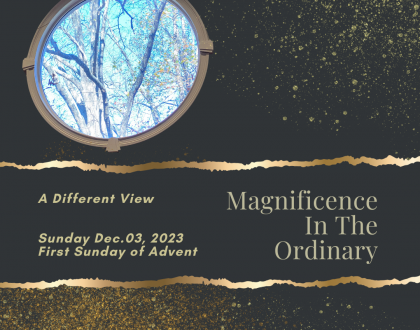A More Accessible Transfiguration

A More Accessible Transfiguration
Bob Stillerman
Transfiguration Sunday, 2/27/2022
2 Corinthians 3:12-4:2
A More Accessible Transfiguration 2 Cor 3.12-4.2 2-27-2022
In Exodus, God’s presence among the Israelites is always accompanied by a supernatural sense of power. Yes, God is good, and compassionate, and just, and merciful. But God is also beyond our comprehension. To look upon God’s face with human eyes is fatal; to listen to God’s voice with human ears is deafening. God is an energy our simple minds and bodies cannot process, and God’s glory is not something we can harness or consume. To be in God’s presence would be akin to standing in the energy of the sun.
Some, however, can get close. God places Moses in the cleft of a massive rock, covering his body with a massive hand. Moses isn’t allowed to see God’s face, but does get to see God’s back. This close contact is so powerful that Moses radiates God’s light for many days to follow, his face turning a glowing and transcendent white. But even second-hand contact is tricky. While Moses enters the tabernacle with an unveiled face to continue his regular conversations with God, he veils his face when speaking to the Israelites, worried that even second-hand illumination might be harmful.
Matthew, Mark, and Luke all recount a similar experience for Jesus, the Transfiguration. One day, Jesus climbs the mountain with a few disciples, and in a sudden flash, he turns a dazzling white, communes with the spirits of Moses and Elijah, and experiences the full presence of God’s glory. Just like Moses, Jesus’ skin and clothes remain a dazzling white after the strange encounter.
For each of the three synoptic gospel writers, the similarities to Moses enhance the credibility of Jesus. For Matthew, Jesus is the fulfilment of Torah, an extension of Moses, and should therefore be rightly credentialed and authentic for Jewish audiences. For Mark and Luke, the story is further testament to the special relationship Jesus has with God, as well as being illustrative of God’s transformative acts through the life and ministry of Jesus. The transfiguration is but another account of signs and wonders that fulfil the prophecy of Jesus, and add merit to tales of resurrection.
Paul, on the other hand, isn’t in a rush to make the transfiguration story one of confirmation. That is to say, Paul isn’t trying to make Jesus a modern-day Moses. Instead, Paul sees the life of Jesus as a kind of decoder ring – something in the Jesus experience alters, and profoundly, the way humanity experiences God. The old covenant (which by the way was not all that old when Paul was living) becomes a new covenant through the lens of Jesus. The God-connection had to be veiled prior to Jesus – intermediaries permitted safe, responsible, meaningful access to the divine: Moses himself, sacrificial rituals, a closed priesthood, a rigid application of law, just to name a few.
Remember, too, that Paul is trained in a Greek method of thinking. He, and others like him, tend to understand divine encounters as having profound effects of transformation. Contact with deities doesn’t zap you, it transforms and empowers you. A little bit of the Godhead rubs off in you. Indeed, Paul understood his own Damascus Road conversion experience as one of transformation. Therefore, Jesus changes the dynamic, or removes the veil to understanding. And in addition, all those who are able to experience the Spirit of God, channeled in the lens of Jesus, are also transformed and empowered.
Moses met God on a mountain. But for whatever reason, God didn’t come all the way back down with him, and dwell freely amongst the people. Jesus went up the mountain, with others, experienced God’s glory, came back down the mountain with others, and God came, too. Fully accessible. Wholly impactful. And here to stay.
Paul says that God’s glory is no longer something that must be deflected. We don’t see God’s image and hold up our hands in a protective crouch. Instead, God’s glory is something that is reflected in each one of us. Because of Jesus, we are now able to look into the mirror of God, and see our own faces staring back.
In such a new reality, Paul tells us to be bold. To live with conviction. For we are not imposters, but are instead, children of God, empowered, emboldened, and embraced in God’s spirit.
I like that Paul points out God’s newfound accessibility, though to be sure, I’m not convinced it ever went missing. Still, I too want a God I can hug and see, One in whose presence I do NOT spontaneously combust.
And of course, we live in a world markedly different than Paul’s, one that has existed for a much longer amount of time than Paul ever imagined. The distance between our time and his time can create an exclusivity in his language. Some can tend to paint the Christian experience as THE channel for fulfilment rather than a channel. I don’t think it was so much that Paul believed one couldn’t commune with God in the ways of the Old Covenant. Certainly, all of us, Paul included, know and recognize the enduring, sacred, and divine witness of Judaism, and the profound effects of its saints on our own faith experiences. I think it was more so that Paul had such a profound and meaningful conversion experience that he was eager for all he encountered to experience that same connectedness with God. Might it be that tradition traded accessibility and exuberance for exclusivity, and it’s hard to undo two millennia of narrative?
But there I go, rambling again. The topic was transfiguration. Be it the writers of Exodus, or the synoptic gospels, or the Apostle Paul, we know a story of communion with God. To encounter the divine is to encounter things more powerful, more mysterious, more wonderful than we can imagine. In Exodus, the encounter is dangerous. In Matthew, Mark, and Luke, eye-witnesses to God’s glory are both either overcome by fear or terrified. I like Paul’s vocabulary the best. Those filled with God’s Spirit experience freedom, reflective glory, truth, self-awareness, and ultimately, transformation.
I’ll be honest with you, I struggle every year to preach about transfiguration, maybe because I’ve used the Luke account five or six times, and I’m not sure what else to say. Or maybe it’s because I just don’t have the energy to try and explain supernatural stories or shoehorn their meaning into tidy and bite-sized pieces. I’m sure I can try again next year.
This morning, we near two full years of a pandemic; and the escalation of yet another violent conflict – today it’s Ukraine that we add to the list of places like Syria, Afghanistan, and Iraq; and we contemplate how to be an equitable and just people amidst the chaos of climate change, and culture change, and social and economic change. And I suppose, now, more than ever, we need to know there is some force at work, some mechanism in the universe, that allows the goodness of God to be reflected and engrained in God’s people.
The truth is, I don’t really care about the specifics of what happened on Mt. Sinai when Moses received the law, or on that mountain Jesus climbed with the disciples, or along the Damascus Road Paul was walking. I wasn’t there, and I’ll never be able to write about those events in the AP style. I’m more interested in this: Moses came down the mountain equipped to help inspire a people; Jesus came down the mountain equipped to a connect a people; Paul rose from a gravely road ready to spread good news to a people. And in each instance, the world was a little better, and God was a little closer, and the future was a little more present.
To transfigure means to transform into something more beautiful or elevated. Good friends, what could be more beautiful, what could be more elevated than God’s people realizing God’s purpose?
Here’s the good news: we don’t have to climb Crowder’s Mountain or the Bank of America Tower, or walk along Interstate 74, or even bleach our clothes a dazzling white to be made more beautiful, or to live into our collective purposes.
We need only to seek God’s spirit in community, and in such spirited gatherings, allow ourselves to live into the freedom, the self-awareness, the truth, the confidence, and the ultimate transformation Paul tells us we will find in the Christ. For it is our own little transfigurations that will ultimately help realize a worldly transfiguration where pandemic, and war, and climate abuse, and inequities are reshaped into healing, and peace, and caretaking, and partnership.
These, friends, are the powerful possibilities of our God. Let’s not deflect. Let’s not tremble in fear. Let’s reflect the loving, transfiguring God of possibilities.
May it be so, and may it be soon! Amen.
Recent Sermons

A Different Sound
December 14, 2023

A Different View
December 04, 2023
Who Will Be Your Angel? Whose Angel Will You Be?
November 14, 2023


